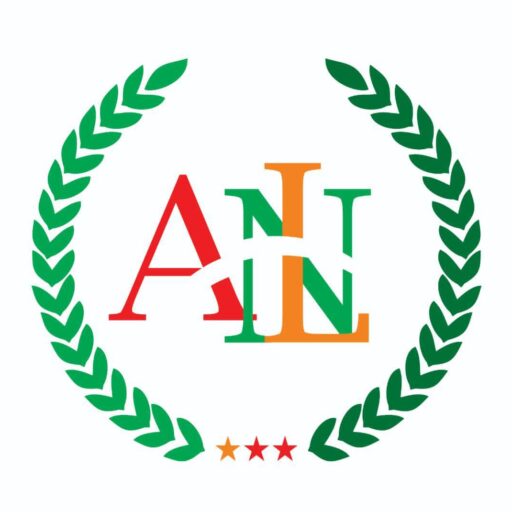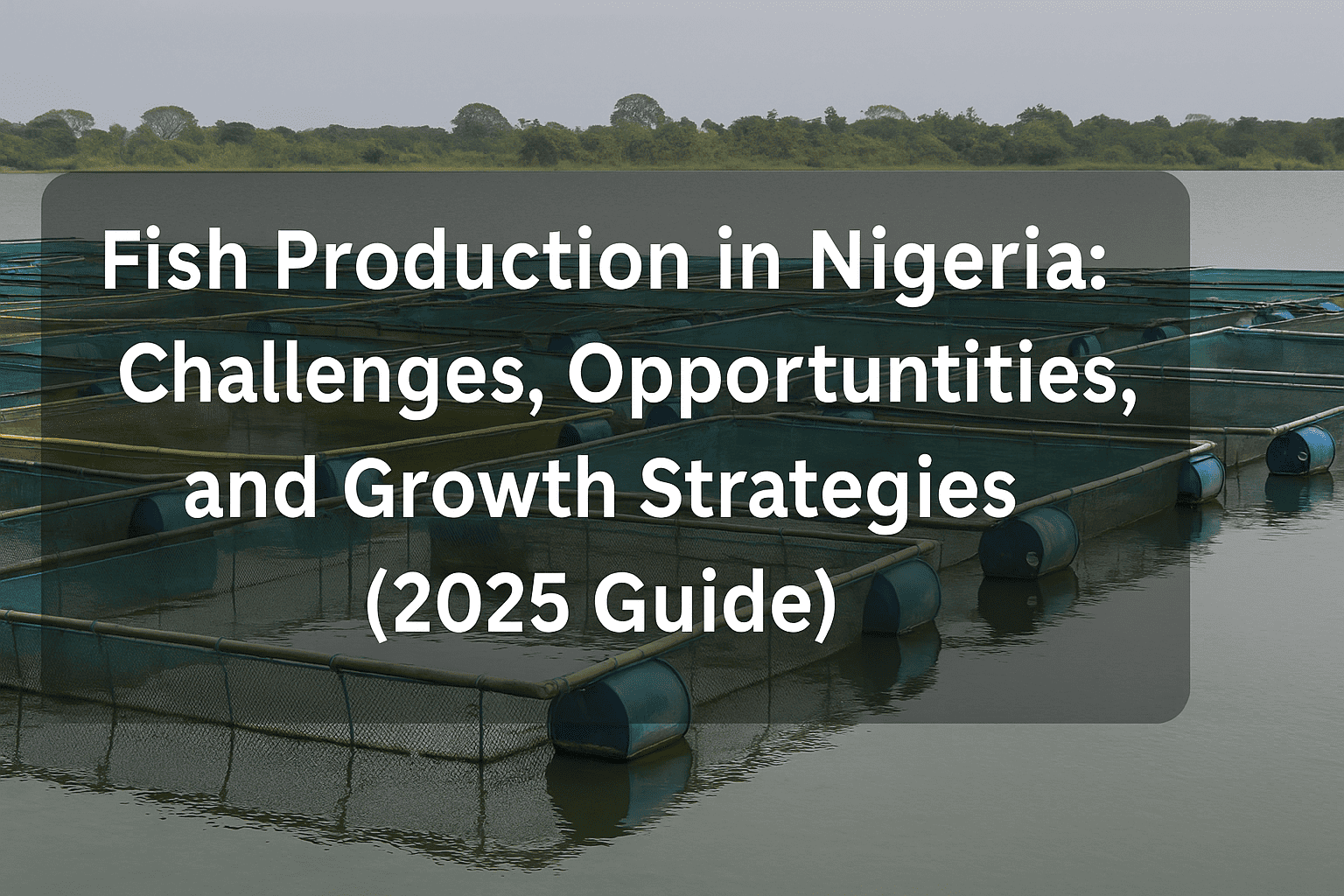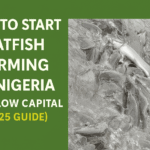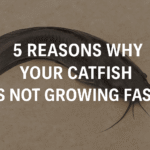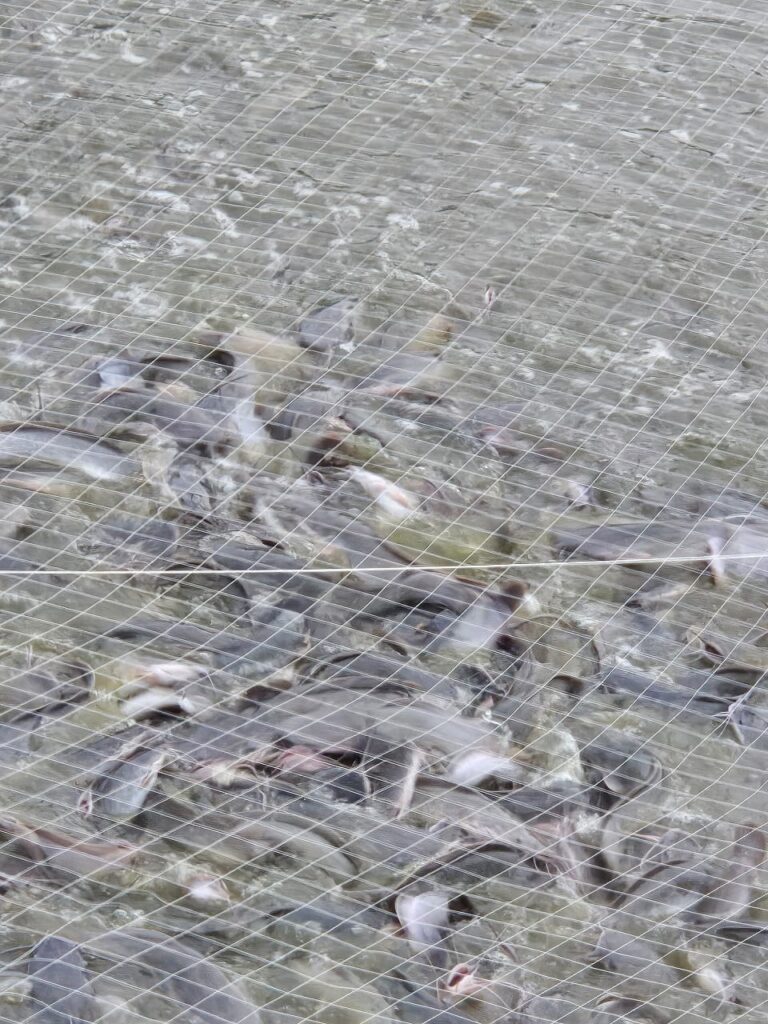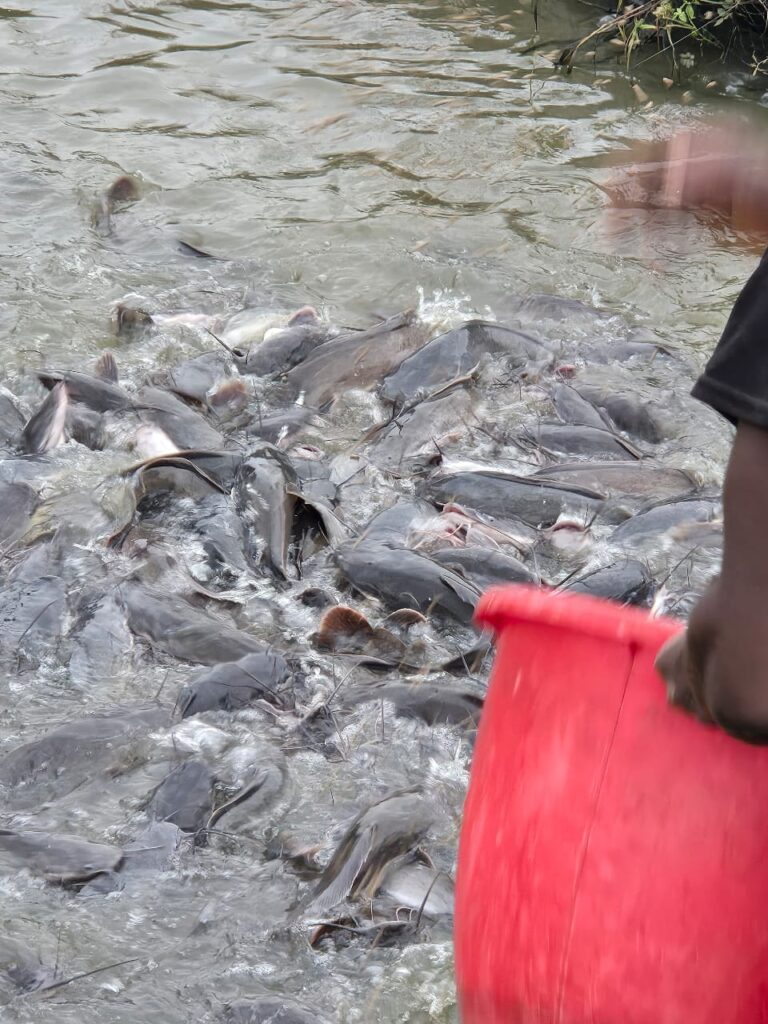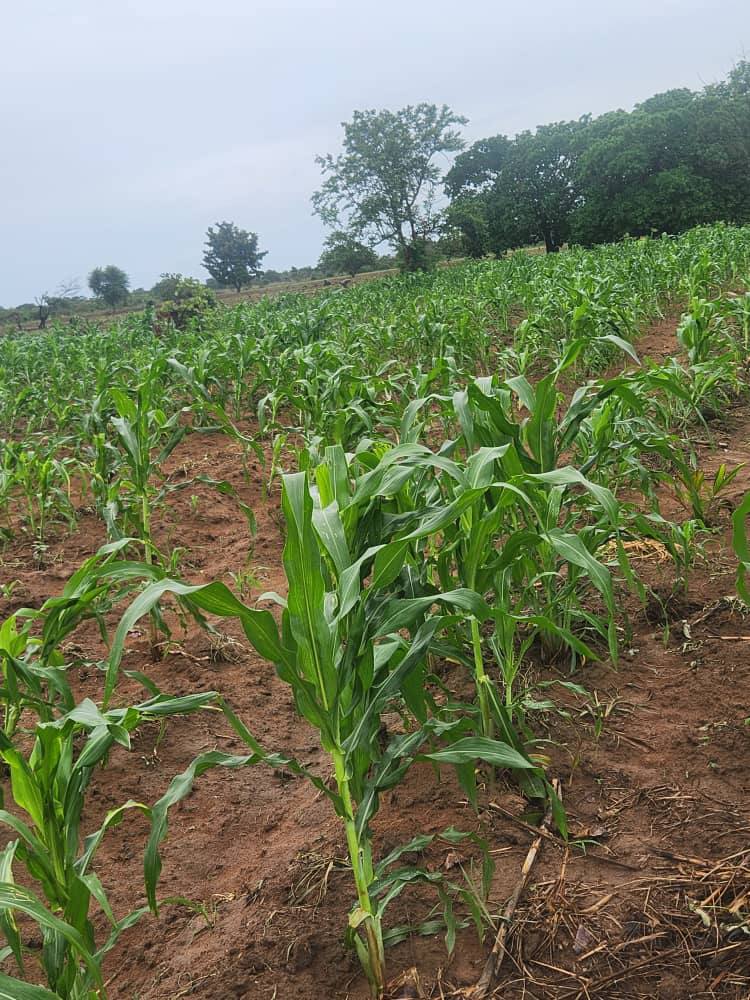Fish production in Nigeria has grown to become a vital sector contributing significantly to the nation's economy and food security. As the most populous country in Africa, Nigeria has a high demand for affordable protein sources, and fish remains one of the primary options for millions of households. Over the years, aquaculture in Nigeria has …
Fish production in Nigeria has grown to become a vital sector contributing significantly to the nation’s economy and food security. As the most populous country in Africa, Nigeria has a high demand for affordable protein sources, and fish remains one of the primary options for millions of households.
Over the years, aquaculture in Nigeria has expanded rapidly in response to the growing need to bridge the gap between fish supply and demand. Traditional fishing methods alone can no longer meet the country’s needs, leading to the rise of fish farming in Nigeria as a sustainable solution.
Among the various types of aquaculture, catfish farming in Nigeria stands out as the most popular. Catfish is preferred because of its fast growth rate, adaptability to different environments, and high market demand. This has made catfish farming a major contributor to fish production in Nigeria, both for local consumption and commercial purposes.
In this 2025 guide, we will explore the challenges, opportunities, and growth strategies shaping the future of fish production and aquaculture in the country.
Current State of Fish Production in Nigeria (2025 Update)
Nigeria holds the reputation as Africa’s top fish consumer, with annual consumption volumes placing it among the largest consumers globally. According to FAO, Nigeria consumes approximately 3.2 million metric tons of fish per year, while national production remains below 1 million metric tons—around 760,000 tons from capture fisheries and 313,000 tons from aquaculture (FAOHome).
Despite rapid growth in fish production in Nigeria, domestic output struggles to meet demand:
- Annual local fish production: 1.2 million tons (worldfishcenter.org, FAOHome)
- Per‐capita consumption: 11.2–11.3 kg per person/year—far below the global average (21 kg) (worldfishcenter.org)
- Import dependency: Nigeria spends roughly $1 billion annually on fish imports (45% of national consumption) (worldfishcenter.org)
A recent projection highlights a widening supply gap, forecasting Nigeria will need an additional 752,000 tons of fish by 2030 just to maintain current per-capita consumption, underscoring the urgency for scaling aquaculture in Nigeria (worldfishcenter.org).
Domestic vs. Imported Fish
| Source | Annual Production (2025) | % of Total Supply |
|---|---|---|
| Aquaculture | 313,000 t | 25% |
| Capture Fisheries | 759,000 t | 75% |
| Total Local | 1,072,000 t | 100% |
| Consumption Need | 3.2 million t | – |
| Imports Needed | 2.1 million t | 65% |
This signals heavy reliance on imported fish, especially pelagic species like mackerel and herring (RSIS International, mel.cgiar.org, FAOHome).
Key Producers in the Fish Farming Ecosystem
- Small-scale and artisanal fishers: Over 70% of domestic fish supply originates from artisanal sources—coastal, inland, creeks, and lagoons (RSIS International). They form the backbone of fish farming in Nigeria, offering local supply and employment.
- Commercial fish farms: Medium to large-scale farms are expanding, largely focusing on catfish farming in Nigeria, the dominant species in aquaculture (MDPI).
- Commercial capture fisheries: Often limited in scale, affected by environmental stressors and declining yields in traditional fishing areas.
Fisheries Landscape 2025
- Small-scale/Artisanal Sector: 77% of all domestic production (ijarm.com, RSIS International).
- Aquaculture Growth: Growing at 12.5% per year (ijarm.com).
- Commercial farms: Accelerating adoption of technologies, but still overshadowed by smallhold operations.
Types of Fish Farming in Nigeria
Fish farming in Nigeria is diverse, offering multiple methods and species that cater to different markets and environmental conditions. Over the years, farmers have adopted various Nigerian fish farming techniques to improve yield, reduce mortality, and maximise profits. Below are the main types of fish farming practised in the country:
1. Catfish Farming in Nigeria
Catfish farming in Nigeria is the most common and profitable form of aquaculture. Catfish is widely accepted by Nigerian consumers due to its soft texture, taste, and adaptability to local cooking methods such as grilling, smoking, and pepper soup.
Catfish farming requires relatively simple infrastructure compared to other species, making it attractive to both small-scale farmers and large commercial operators. The availability of fingerlings, growing knowledge of feed formulation, and increased market demand have made catfish a dominant species in Nigeria’s fish farming techniques.
2. Tilapia Farming
While catfish dominates, tilapia farming is also gaining attention, especially in regions with access to freshwater lakes and ponds. Tilapia is valued for its fast growth rate, high feed conversion efficiency, and ability to thrive in various environments. However, tilapia is less popular than catfish due to market preferences and fewer consumer recipes dedicated to tilapia in Nigeria.
3. Other Aquaculture Systems
Modern aquaculture in Nigeria has introduced other innovative farming systems to meet increasing demand and overcome land limitations:
- Cage Culture: Farmers raise fish in floating cages placed in rivers, lakes, or reservoirs. This method is cost-effective for large-scale production.
- Concrete Tanks & Plastic Ponds: Ideal for urban fish farming, where space is limited, tanks and tarpaulin ponds allow better management of water quality and fish health.
- Earthen Ponds: Traditional but still popular, especially in rural areas where land and water are available. However, earthen ponds require careful maintenance to prevent disease outbreaks.
4. Capture Fisheries vs Fish Farming
Capture fisheries involve harvesting fish from natural water bodies like rivers, lakes, and the ocean. While this method has been the traditional source of fish in Nigeria, it is facing serious decline due to overfishing, pollution, and climate change.
In contrast, fish farming in Nigeria (aquaculture) offers a controlled environment for fish production, helping to reduce dependence on capture fisheries. With innovations in Nigeria’s fish farming techniques, aquaculture has become the future of sustainable fish supply in the country.
Fish Pond Management in Nigeria
Proper fish pond management in Nigeria is crucial for the success of any fish farming operation. Whether a farmer is running a small backyard pond or a large commercial farm, maintaining the pond environment directly affects fish health, growth rates, and overall profitability.
Below are the key components of effective Nigerian fish farming techniques related to pond management:
1. Setting Up and Maintaining Fish Ponds
The first step in fish pond management in Nigeria is choosing the right location and pond type. Fish farmers can choose between:
-
Earthen ponds
-
Concrete tanks
-
Plastic or tarpaulin ponds
Each pond type requires careful design to ensure proper drainage, aeration, and accessibility. Farmers must regularly inspect the pond walls, inlets, and outlets to prevent leakages or structural damage. Proper pond maintenance also includes clearing out weeds, debris, and accumulated waste that can contaminate the water or harm the fish.
2. Water Quality Management
Maintaining good water quality is one of the most important Nigerian fish farming techniques. Poor water conditions can lead to diseases, stunted growth, and high mortality rates. Farmers must monitor key factors such as:
-
Oxygen levels: Ensure adequate aeration, especially during hot weather.
-
pH balance: Keep the water pH between 6.5 and 8.5 for optimal fish health.
-
Temperature control: Fish grow best in water temperatures between 26°C to 30°C.
-
Ammonia and waste management: Regular water changes or use of biofilters help reduce waste buildup.
Consistent water monitoring helps prevent stress and disease, ensuring healthy fish production.
3. Stocking Density and Pond Hygiene
Stocking the right number of fish per pond is essential to avoid overcrowding, which can lead to poor growth and increased disease risks. The recommended stocking density varies depending on the fish species, pond size, and production goals. For catfish farming in Nigeria, a common guideline is 1000–1500 fingerlings per 10 x 10 meters pond, though this can vary based on management capacity.
Pond hygiene is equally important. Farmers should:
-
Remove dead fish promptly to prevent contamination.
-
Clean feeding areas to avoid leftover feed decay.
-
Regularly siphon out waste from the pond bottom.
-
Use probiotics or natural water treatment methods to maintain ecological balance.
By following best practices in fish pond management in Nigeria, farmers can improve survival rates, maximise yields, and run more profitable fish farming operations.
Fish Feed Production in Nigeria
Fish feed production in Nigeria plays a critical role in the success of aquaculture. Feed accounts for up to 70% of total production costs, making it the single largest expense for fish farmers. The quality and availability of feed directly impact fish growth rates, survival, and profitability.
Importance of Quality Feed for Healthy Fish Growth
Healthy fish growth depends on balanced nutrition. Fish require a diet rich in proteins, vitamins, fats, and minerals to reach market size efficiently. Poor-quality or poorly formulated feed leads to:
-
Slow growth
-
High feed conversion ratios (FCR)
-
Increased mortality
-
Poor market value of the fish
For this reason, many farmers prioritise sourcing high-quality feed, whether from local producers or international brands, to ensure successful harvests.
Locally Produced vs Imported Fish Feed
In recent years, fish feed production in Nigeria has grown, with several local companies now producing pelleted feeds for catfish, tilapia, and other species. However, many farmers still rely on imported fish feed due to perceived higher quality and better nutritional composition.
Locally Produced Fish Feed
-
More affordable and accessible
-
Reduces dependence on imports
-
Often lacks consistent quality control
-
Sometimes suffers from poor storage and spoilage
Imported Fish Feed
-
Usually has better formulation and performance consistency
-
Higher cost due to exchange rates and shipping
-
It may not always be readily available in remote areas
Balancing cost with quality remains a challenge for most fish farmers in Nigeria.
Challenges in Fish Feed Production
Despite the growth of fish feed production in Nigeria, several challenges persist:
-
High cost of raw materials like soybean, fishmeal, and maize
-
Inconsistent feed quality due to a lack of regulation in local feed mills
-
Storage problems leading to mould or spoilage
-
Limited research and development for species-specific feed formulation
-
Importation of additives and supplements, which increases production costs
These challenges contribute to the high cost of fish farming and hinder the sector’s full potential.
Opportunities for Feed Manufacturing Businesses
The increasing demand for fish across Nigeria presents a huge opportunity for investment in fish feed production in Nigeria. Entrepreneurs can tap into this market by:
-
Setting up modern, quality-controlled feed mills
-
Investing in research to produce affordable, high-protein feeds from local ingredients
-
Developing feeds tailored for different growth stages and species
-
Offering bulk supply options to small-scale farmers at competitive prices
By addressing these gaps, local feed manufacturers can not only reduce farmers’ dependence on imports but also drive innovation in Nigeria’s aquaculture sector.
Fish Processing and Marketing in Nigeria
Fish processing and marketing in Nigeria are vital components of the aquaculture value chain. After harvest, fish must be processed and distributed efficiently to reach consumers in good condition. Proper processing not only preserves fish but also adds value, creating more income opportunities for farmers, traders, and entrepreneurs.
Processing Methods
Nigeria uses several traditional and modern methods to process fish, with the most common being:
-
Smoked Fish: Smoking is one of the oldest and most popular fish preservation techniques in Nigeria. Smoked catfish and tilapia are widely consumed across the country. Smoking enhances shelf life, reduces spoilage, and adds a distinct flavor that is in high demand locally and abroad.
-
Dried Fish: Sun-drying is another traditional method, especially in rural areas. It helps preserve fish for longer storage but can be affected by weather conditions and hygiene challenges.
-
Frozen Fish: Freezing is commonly used by commercial fish farms and processors, especially for export or supply to supermarkets and restaurants. Cold chain storage is required to maintain quality, which makes this method more capital-intensive.
Fish Marketing Channels
Fish processing and marketing in Nigeria involve various channels that move fish from farmers to final consumers. The main marketing channels include:
-
Local markets: Open markets are the primary distribution point for smoked, dried, and fresh fish. Fish traders buy directly from farms or fishing communities and sell in retail or wholesale quantities.
-
Restaurants and hotels: Many urban fish farmers supply directly to hotels, restaurants, and grilled fish joints that require consistent quality and supply.
-
Supermarkets and cold stores: Frozen fish is packaged and sold in supermarkets, especially in big cities.
-
Export opportunities: Smoked catfish from Nigeria has gained popularity in international markets, especially in Europe and North America, where there is a large Nigerian diaspora. Exporting smoked and dried fish offers additional income streams for processors who meet quality and packaging standards.
Fish Supply Chain in Nigeria: From Pond to Consumer
The fish supply chain in Nigeria starts from fish hatcheries, where fingerlings are bred. Farmers grow the fish in ponds, tanks, or cages and sell them to middlemen, processors, or directly to consumers.
The supply chain typically follows these steps:
-
Production (Pond/Tank/Cage Farming)
-
Harvesting
-
Processing (Smoking, Drying, Freezing)
-
Packaging and Storage
-
Transportation to Markets or Export Centres
-
Retail Sales (Local Market, Restaurant, Supermarket, or Export)
Challenges like poor transportation infrastructure, lack of cold chain logistics, and inconsistent market prices can affect the efficiency of the fish supply chain in Nigeria. However, innovations in packaging, storage, and direct-to-consumer sales through online platforms are helping farmers and marketers improve profitability.
Fish Market Prices in Nigeria (2025 Insight)
Understanding fish market prices in Nigeria is essential for both fish farmers and consumers. As of 2025, the market is influenced by several factors, including production costs, feed prices, fuel costs, seasonal changes, and regional demand. Fish remains a staple protein in most Nigerian households, making its pricing a major concern for the general population.
Current Fish Market Trends
The fish market prices in Nigeria have experienced a steady increase over the past few years due to rising production costs, especially for feed and transportation. In 2025, the average price of catfish—the most commonly farmed fish—ranges between ₦1,500 to ₦2,200 per kilogram, depending on location, size, and quality.
Similarly, smoked catfish can sell for ₦8,000 to ₦12,000 per kilogram, especially when prepared for export or supplied to premium markets. Tilapia, though less popular than catfish, maintains an average retail price of ₦1,300 to ₦1,800 per kilogram, depending on freshness and processing method.
Imported frozen fish, such as mackerel, sardines, and croaker, still dominate parts of the market, but due to naira devaluation and import costs, their prices have also risen significantly.
Price Variations by Region and Season
Fish market prices in Nigeria are not uniform across the country. They vary based on:
-
Region: Coastal areas like Rivers, Bayelsa, and Lagos State often have lower fish prices due to proximity to fishing activities. Inland states such as Kano, Kaduna, and Abuja face higher prices due to transportation costs and limited supply.
-
Seasonality: During the dry season, natural water bodies shrink, reducing fish supply from capture fisheries. This leads to higher demand for farmed fish and price hikes. Conversely, in the rainy season, increased availability from rivers and lakes may lower prices slightly, though farmed fish still maintains stable demand.
How Fish Farmers Can Maximise Profits
To stay profitable amid fluctuating fish market prices in Nigeria, fish farmers should adopt smart strategies, such as:
-
Reduce production costs: By Formulating local feeds, optimise pond management, and prevent disease outbreaks to cut expenses.
-
Diversify processing methods: Sell both fresh and processed (smoked or dried) fish to access multiple market segments and increase earnings.
-
Direct marketing: Sell directly to consumers, restaurants, or retailers to avoid middlemen and retain more profit.
-
Leverage technology: Use social media, WhatsApp, and online marketplaces to reach more customers and create consistent demand.
-
Bulk sales and contracts: Establish supply contracts with hotels, supermarkets, and export companies to guarantee sales at fair prices.
By keeping track of market trends and applying these strategies, fish farmers in Nigeria can better navigate price volatility and build sustainable businesses.
Challenges of Fish Production in Nigeria
Despite its growing potential, there are several challenges to fish production in Nigeria that limit the full growth of the industry. From high input costs to post-harvest losses, fish farmers face numerous obstacles that affect profitability and sustainability.
Below are the key challenges currently affecting fish production in Nigeria:
1. High Cost of Fish Feed
The most significant expense in fish farming is feed, accounting for up to 70% of production costs. Rising prices of raw materials like soybean meal, fishmeal, and maize have made feed increasingly expensive. This leads to:
-
Reduced profit margins for farmers
-
Increased fish prices for consumers
-
Temptation to use low-quality feed, resulting in poor fish growth
Without affordable, high-quality local feed options, fish production in Nigeria will continue to face this financial barrier.
2. Poor Access to Credit and Finance
Many small and medium-scale fish farmers struggle to access loans or financial support. Most banks consider agriculture and aquaculture high-risk sectors, leading to:
-
Limited funding for expansion
-
Inability to invest in modern equipment or quality inputs
-
Dependence on personal savings or informal lenders
This lack of financial inclusion slows down growth and discourages new entrants into the sector.
3. Inadequate Infrastructure and Technology
The absence of modern infrastructure is a major challenge to fish production in Nigeria. Issues include:
-
Poor road networks that increase transportation costs
-
Lack of cold chain storage for processed or fresh fish
-
Limited availability of advanced fish pond management in Nigeria, such as automated feeding systems, aerators, and water quality monitors
-
Many farmers still rely on outdated techniques, reducing efficiency and increasing losses.
4. Fish Diseases and Pond Management Issues
Fish diseases such as bacterial infections, fungal outbreaks, and parasitic infestations can wipe out entire ponds if not managed properly. Poor fish pond management in Nigeria contributes to:
-
Water quality degradation
-
Overcrowding and stress-related illnesses
-
Lack of veterinary support or diagnostics for fish health issues
These problems result in high mortality rates and lower yields.
5. Post-Harvest Losses
After harvesting, many farmers face losses due to improper handling, lack of storage facilities, and poor processing techniques. Post-harvest losses can be as high as 20–30%, particularly in rural areas without access to:
-
Refrigeration
-
Hygienic processing centres
-
Safe transportation
This reduces the overall profitability of fish farming.
6. Market Instability
Fish market prices in Nigeria fluctuate due to seasonal demand, inflation, and competition from imported fish. Without stable market prices, farmers face uncertainties in planning production cycles. This makes long-term business sustainability difficult.
Addressing the challenges of fish production in Nigeria requires coordinated efforts from the government, the private sector, and farmers themselves. By improving fish pond management in Nigeria, reducing feed costs, and enhancing infrastructure, the industry can unlock its full potential and meet the country’s growing demand for fish.
Opportunities and Growth Strategies for Fish Production in Nigeria
Despite the existing challenges, the future of fish production in Nigeria holds immense potential. With the country’s increasing population and rising demand for fish, there are several opportunities for growth in the aquaculture sector. Strategic investments and policy reforms can transform Nigeria into a self-sufficient fish-producing nation.
1. Investment in Fish Farming Equipment and Technology
Modernising fish farming in Nigeria is a key growth area. Farmers can improve efficiency and production through:
-
Automated feeding systems
-
Water quality monitoring tools
-
Recirculating Aquaculture Systems (RAS)
-
Improved hatchery technologies
These innovations reduce labour, minimise losses, and promote sustainable aquaculture in Nigeria, especially for large-scale commercial farms.
2. Capacity Building and Training for Farmers
Many small-scale farmers lack technical knowledge about Nigerian fish farming techniques. There is a growing need for:
-
Training programs on pond management, disease control, and breeding techniques
-
Workshops and extension services to introduce farmers to modern aquaculture methods
-
Online and offline mentorship platforms to support new entrants into the fish farming business
This will enhance productivity and improve the quality of fish produced across the country.
3. Expansion of Fish Feed Production
Improving fish feed production in Nigeria presents a major opportunity. By expanding local feed manufacturing, the industry can reduce reliance on costly imports and stabilise production costs. Growth strategies include:
-
Investing in local feed mills
-
Researching alternative protein sources such as insect meal, agricultural by-products, or plant-based proteins
-
Developing affordable, high-nutrient feeds tailored to Nigerian aquaculture needs
A vibrant local feed sector will lower barriers for both new and existing farmers.
4. Development of Efficient Fish Supply Chains
Strengthening the fish supply chain in Nigeria is essential to minimise post-harvest losses and stabilise market prices. Growth strategies include:
-
Building modern storage and cold chain logistics
-
Improving transportation infrastructure
-
Supporting digital marketplaces to connect farmers directly to buyers
-
Encouraging cooperative societies to help small-scale farmers access larger markets
This will ensure that fish move smoothly from farm to consumer, increasing profitability and reducing waste.
5. Improved Fish Processing and Export Opportunities
Expanding fish processing and marketing in Nigeria opens doors for local and international trade. With proper processing techniques like smoking, drying, and freezing, farmers and processors can add value and access broader markets. Exporting smoked catfish and tilapia to the diaspora is a growing business, but success requires:
-
Compliance with international quality standards
-
Better packaging and branding
-
Access to export logistics and documentation support
This will help position Nigeria as a major player in the global fish market.
6. Government Support and Policy Incentives
The government plays a crucial role in driving the growth of aquaculture in Nigeria. Opportunities exist for:
-
Low-interest loans and grants for fish farmers and processors
-
Tax incentives for fish feed manufacturers and equipment importers
-
Fisheries development policies to support training, research, and infrastructure
-
Public-private partnerships (PPP) to develop large-scale aquaculture projects
Supportive policies will encourage investments and foster long-term growth in the industry.
By embracing these opportunities and growth strategies, Nigeria can strengthen its position as a leader in African aquaculture, reduce fish imports, create jobs, and improve national food security.
Frequently Asked Questions (FAQs)
What are the major challenges of fish production in Nigeria?
The challenges of fish production in Nigeria include the high cost of fish feed, limited access to affordable credit, inadequate infrastructure, poor fish pond management in Nigeria, disease outbreaks, and post-harvest losses. Additionally, market instability and competition from imported fish also affect profitability.
How profitable is catfish farming in Nigeria?
Catfish farming in Nigeria is highly profitable when managed properly. With the right feeding practices, good pond management, and access to a ready market, farmers can expect a return on investment within 4–6 months. Profit margins depend on production costs, market prices, and the scale of operations.
What is the current price of fish in Nigeria?
As of 2025, the fish market prices in Nigeria range from ₦1,500 to ₦2,200 per kilogram for live catfish. Smoked catfish sells for around ₦8,000 to ₦12,000 per kilogram, depending on quality and location. Prices vary based on region, season, and processing method.
How do I start a fish farming business in Nigeria?
To start fish farming in Nigeria, follow these basic steps:
-
Choose the right fish species (e.g., catfish or tilapia).
-
Select a location and build suitable ponds (earthen, concrete, or tarpaulin).
-
Source quality fingerlings from trusted hatcheries.
-
Set up a feeding plan using high-quality feed or locally formulated feed.
-
Manage water quality and monitor pond hygiene.
-
Plan for harvesting and marketing by identifying your target market in advance.
You can read this detailed guide:
How to Start Catfish Farming in Nigeria with Low Capital (2025 Guide)
Conclusion
Fish production in Nigeria is a vital industry that supports food security, employment, and economic growth. From small-scale fish farming in Nigeria to commercial aquaculture in Nigeria, the sector has witnessed significant expansion but still faces challenges such as high feed costs, limited access to finance, and post-harvest losses.
By adopting modern Nigerian fish farming techniques, improving fish pond management and investing in fish feed production in Nigeria, farmers can increase productivity and meet the nation’s growing fish demand. Additionally, expanding fish processing and marketing in Nigeria and developing efficient supply chains will help reduce waste and improve profitability.
The future of fish production depends on embracing sustainable fish farming practices that protect the environment while maximising yields. This includes using quality feed, maintaining good water management systems, and following ethical farming standards.
There are vast opportunities for entrepreneurs, investors, and policymakers to contribute to the growth of Nigeria’s fishery sector. With the right investments and support, Nigeria can become a leader in African aquaculture and significantly reduce its dependence on fish imports.
Want to learn more? Contact us for expert advice, quality fingerlings, and premium fish feed to help you succeed.
